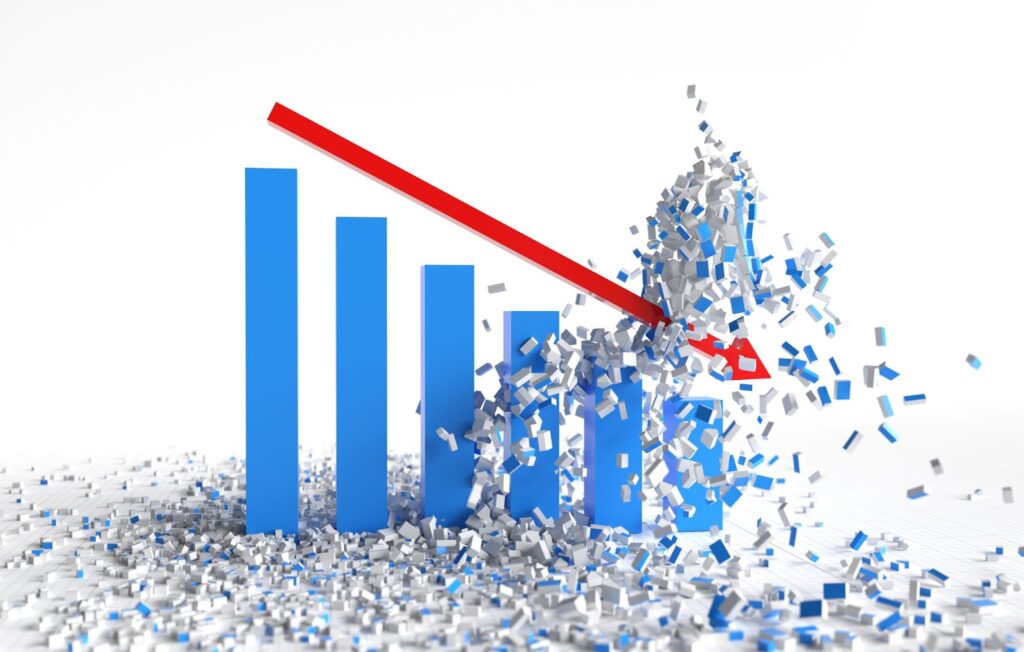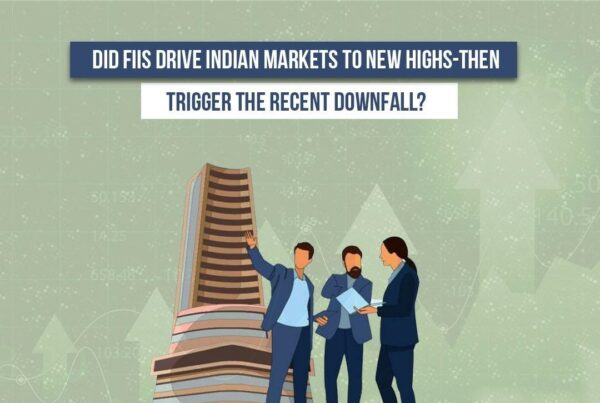Inflation is a significant challenge that can undermine your financial health if not properly managed. Over time, it erodes the purchasing power of your money, diminishing the value of your investments.
Before you start investing in a particular avenue, it’s crucial to understand what is inflation, the factors influencing its rate, and most importantly, how it can affect the value of your investments over time.
Key takeaways,
- What is Inflation? – Inflation explained in simple terms
- Impact of Inflation on Various Asset Classes
- How to Safeguard Your Investments from Inflation?
- Conclusion
What is Inflation?

Inflation is the rate at which prices of goods and services go up year on year. When inflation occurs the value of money reduces, which in turn reduces your purchasing power. In essence, it means you’ll need more money to purchase the same item!
For eg: if a pack of bread costs ₹100 today and inflation runs at 8% annually, next year, the same pack could cost around ₹108.
The Reserve Bank of India (RBI) monitors inflation to prevent it from rising too quickly, which could destabilize the economy. They use the Consumer Price Index (CPI) to measure inflation. The CPI tracks the prices of commonly purchased items, such as food, housing, and transportation, to gauge the cost of living.
Factors that affect Inflation
Some of the key factors affecting inflation include
Supply and Demand Imbalance: Simply put, when the demand for products or goods increases but the supply remains limited, prices go up. This imbalance can occur when companies or agricultural fields cannot meet the demand or when disruptions reduce production. For example, Kerala relies heavily on vegetables from neighbouring states like Tamil Nadu. If Tamil Nadu’s agriculture is affected by heavy rain, reducing vegetable production, the prices in Kerala will rise due to the limited supply.
Supply Chain Disruptions: Disruptions in the transportation of goods from one region or country to another can significantly affect inflation rates. For example, global energy prices spiked during Russia’s invasion of Ukraine. In response to international sanctions, Russia cut off global energy supplies, tightening the market and causing prices to soar. This drop in energy supplies led to higher prices, impacting the cost of goods and services worldwide.
Global Commodity Price Fluctuations: Changes in the prices of commodities like oil, metals, and agricultural products on the global market can directly impact domestic prices, influencing inflation rates. When oil prices rise, transportation costs increase, resulting in higher prices for goods. Similarly, increased metal prices raise the costs of vehicles and daily utensils made from these materials, contributing to inflation.
These fluctuations can stem from various factors such as supply and demand dynamics, geopolitical events, natural disasters, economic policies, and market speculation. For instance, during the recent Russia-Ukraine conflict, oil prices surged due to supply chain disruptions and sanctions on Russian energy exports. In a similar vein, the invasion of Kuwait by Iraq in 1990 led to a notable increase in oil prices due to concerns over potential supply disruptions, affecting the global oil supply.
These changes in commodity prices lead to higher production and transportation costs, which businesses often pass on to consumers through increased prices for goods and services, thereby contributing to overall inflation.
Anticipated Inflation Among Employees: When employees anticipate price increases, they may request higher wages. In response, companies often raise prices to cover these increased costs, which contributes to inflation.
Government Policies: Government policies, such as taxation, subsidies, and monetary measures, play a crucial role in shaping economic dynamics and impacting inflation levels. Taxation policies directly affect consumer spending power and business profitability, thereby influencing demand and supply conditions in the economy.
Subsidies provided by governments can alter production costs and consumer prices, impacting inflationary pressures. Additionally, monetary measures like interest rate adjustments by central banks influence borrowing costs, investment decisions, and overall economic activity, further impacting the inflation rate.
Impact of Inflation on Various Asset Classes

Investors often make the mistake of ignoring inflation when calculating their investment returns. For instance, if your return on investment is 6% but the inflation rate is 7%, your money is actually losing value in real terms.
Understanding how inflation impacts different asset classes is essential for investors aiming to protect and grow their wealth. Let’s explore the specific effects of inflation on various investment avenues:
Stocks and Mutual Funds
Stocks and mutual funds are popular investment options that can help protect your money from losing value due to inflation over the long term.
Historically, successful companies have provided returns exceeding 10% per year. These companies can raise the prices of their products and services in response to inflation. This ability to adjust helps them maintain their earnings and support their stock prices.
By investing in mutual funds, you benefit from the collective performance of different asset classes including stocks, which can also adjust to inflation.
However, stocks and mutual funds are not completely immune to inflation. When inflation is moderate (1-3% per year), the stock market generally performs well. Companies manage costs and adjust prices without major issues.
High inflation creates uncertainty, reduces consumer spending, and slows economic growth, leading to market volatility. To combat high inflation, the Reserve Bank of India (RBI) may raise interest rates, making it harder for companies to borrow money and expand, which can negatively impact stock prices.
In summary, while stocks and mutual funds are good long-term defenses against inflation, they can still be affected, especially during periods of high inflation.
Bonds
Inflation can have both negative and positive effects on bonds. Fixed interest payments lose their value when inflation rises. For instance, holding a bond yielding 6% in an environment with 7% inflation results in a negative real return.
There are high-yield bonds with returns exceeding 10%, but it’s crucial to consider the credit rating and security of the bond before investing. High-yield bonds come with higher risks, and their stability can vary significantly.
When inflation rises, central banks typically increase interest rates to combat it. This leads to the issuance of new bonds with higher interest rates, causing the prices of existing bonds to drop to match the new, higher yields. Conversely, when inflation falls, central banks cut interest rates, leading to new bonds with lower rates and boosting the prices of existing bonds due to their relatively higher returns.
The inverse relationship between interest rates and bond prices means that inflation indirectly impacts bond yields and prices. Government securities and AAA-rated bonds tend to be more stable, while lower-rated bonds are more volatile. Understanding this relationship is key to navigating bond investments during different inflationary periods.
Fixed Deposits (FDs)
Fixed deposits offer fixed interest rates over a specified period, making them one of the safest forms of investment. However, like bonds, FDs do not perform well in relation to inflation.
Here is the list of recent inflation rates in India:
2024: 4.83% (April)
2023: 5.49%
2022: 6.7%
2021: 5.13%
2020: 6.62%
India’s major banks and small finance banks are currently offering interest rates ranging from 6-9%, which can help counteract inflation to some extent. However, despite the slight increase in your money, the actual value after adjusting for inflation may not be satisfying. During periods of high inflation, the real return on FDs can even be negative if the inflation rate surpasses the interest rate offered.
If you’re considering FDs, look for those with high interest rates, especially from small finance banks. However, for long-term growth, it’s better to diversify into inflation-protected securities and other asset classes. This approach helps reduce the risk of inflation gradually eroding your returns.
Real Estate
Inflation has a mixed impact on real estate investments. During high inflation, property values tend to rise, allowing property owners to set higher asking prices, making it a good time to sell existing properties. Conversely, during low inflation, lower property prices and borrowing costs make it an ideal time to buy and invest in real estate.
High inflation drives up the cost of construction materials, making new properties more expensive to develop. This increases prices for both new and existing real estate. Investors benefit from rising property values, which boost their return on investment (ROI).
Moreover, increased demand for rental properties during periods of inflation drives up rents, benefiting landlords. However, inflation also leads to higher borrowing costs as lenders raise interest rates to combat currency devaluation. This makes it more expensive for both buyers and developers to finance their projects.
Real estate is often a good way to protect your money from inflation, as long as you know when to buy, sell, and hold during uncertain economic times.
Commodities
Commodities, including precious metals like gold and silver, tend to perform well during inflationary periods. As currency depreciates, these assets typically rise in value, making them a popular choice for hedging against inflation. In India, gold has always been a safe-haven investment.
Cash
Holding cash during inflationary periods is generally not recommended because inflation erodes its purchasing power over time. While cash provides liquidity, it offers no growth potential. Maintaining liquid cash or large amounts in savings accounts with low-interest rates can lead to a significant loss of purchasing power.
Despite the drawbacks of keeping substantial sums in liquid and savings accounts, maintaining an emergency fund in cash or a savings account is essential for unforeseen expenses.
How to Safeguard Your Investments from Inflation?

Now that we’ve explored how inflation affects various asset classes, it’s essential to understand how to safeguard your investments from its erosive effects.
Diversification
A diversified portfolio can reduce inflation risks by spreading investments across various asset classes like stocks, mutual funds, bonds, real estate, commodities, and inflation-protected securities. This strategy helps balance potential negative impacts on certain investments with positive returns from others, thereby safeguarding your overall wealth.
Investing in Short-term Bonds
Investing in short-term bonds is a smart move during inflation. These bonds are less affected by interest rate changes compared to long-term bonds. When rates go up, you can reinvest in short-term bonds at higher rates, keeping your investment value intact. This strategy helps protect your money from inflation’s impact while potentially earning higher returns.
Invest For Long-Term
Investing for the long term in different asset classes (mutual funds, stocks, bonds, gold etc) offers substantial potential returns despite facing inflation risks. These investments have historically proven effective in achieving growth over extended periods. While they may experience short-term volatility due to economic fluctuations and inflationary pressures, their ability to compound returns over time can help mitigate the impact of inflation and enhance wealth accumulation.
Consulting a financial expert can help you choose funds that match your goals and risk tolerance. Their suggestions help manage inflation risks and market fluctuations, safeguarding your investments and capitalizing on growth opportunities.
Inflation-Protected Securities
In India, inflation-indexed bonds (IIBs) are designed to protect investors from inflation. These bonds adjust their principal and interest payments according to inflation rates, ensuring that fixed-income investors preserve their purchasing power over time.
Real Estate and Real Estate Investment Trusts (REITs)
Investing in physical real estate and REITs. REITs allow investment in real estate without direct property ownership. In India, REITs such as Embassy Office Parks REIT and Mindspace Business Parks REIT provide attractive dividends and serve as a hedge against inflation.
As property values and rental incomes increase during inflationary periods, real estate investments can potentially offer stable returns.
Commodities and Precious Metals
Diversifying your portfolio with commodities and precious metals like gold and silver can act as a safeguard against inflation. In India, gold is particularly favored during times of inflation. Investing in physical gold, gold ETFs or sovereign gold bonds issued by the government allows investors to benefit from the appreciation of these assets during inflationary cycles.
Foreign Investments
Investing a portion of your savings in foreign assets can effectively hedge against domestic inflation. Diversifying internationally helps mitigate the impact of inflation in any single country.
You can buy foreign stocks directly or invest in mutual funds and ETFs that focus on global markets. This approach offers advantages like currency diversification and exposure to various economic conditions worldwide.
Conclusion
Inflation, an unavoidable economic force, diminishes purchasing power and impacts different asset classes uniquely. Safeguarding your investments against these risks and enjoying peace of mind from inflation requires strategic planning and timely execution across various avenues. Understanding economic conditions and seeking suggestions from financial experts are crucial steps to effectively hedge against inflation and discover growth opportunities in the market.
For expert guidance on planning and managing your inflation-protected investments, visit Moolaah to consult with a registered financial expert free of charge.




